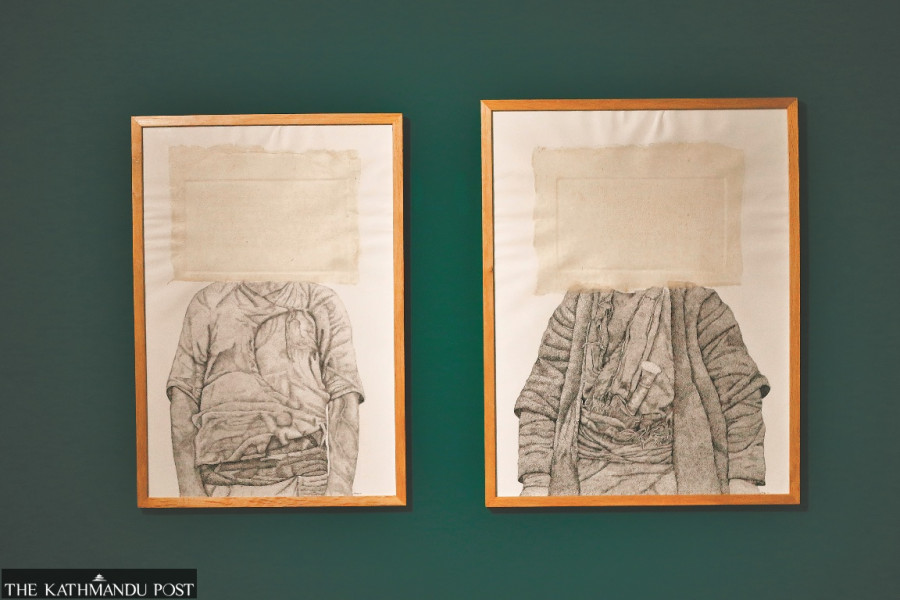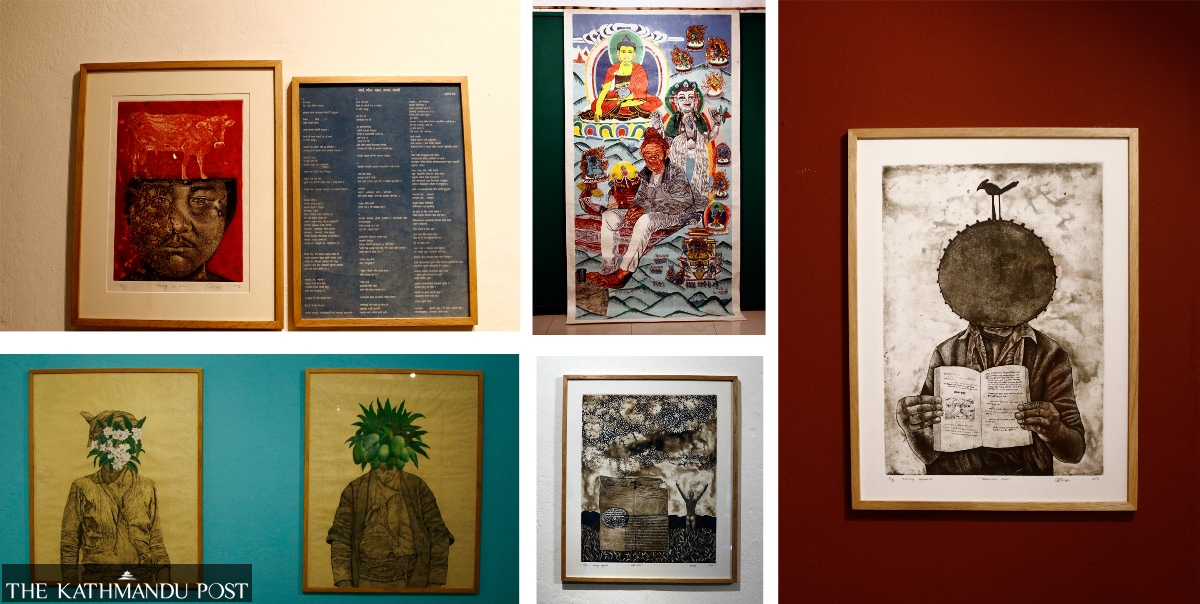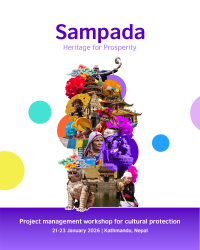Culture & Lifestyle
Archiving Tamang community’s excluded history
Visual artist Subas Tamang’s ongoing exhibition, ‘Kaiten: History, Memory and Identity’ is an attempt to document the history of the Tamang community.
Srizu Bajracharya
When visitors arrived at the Siddhartha Art Gallery on a recent afternoon to look at the gallery’s ongoing exhibition, ‘Kaiten: History, Memory and Identity’, many of them were immediately hooked on the aesthetics of the artworks. Through the hallway, they moved quietly and carefully to discern the details of the images.
What stands out in the exhibition is the ‘Kaiten’ (storytelling in Tamangbhasa) of the Tamang people like never before. The exhibition offers people a glimpse of Tamang history and the lasting impact of the state’s suppression and oppression of the community.
At the heart, the exhibition discusses the struggles of an indigenous community that has lost so much of its identity and culture to years of singular development in the country. The exhibition presents the community’s years of struggles and resistance in a raw and untempered way. And it confronts the inner turmoil of the younger generation: Where and how do you begin to recover what has been lost?
The exhibit includes visuals that show the misunderstood identity of the Tamangs as ‘Bhotes’, which is loosely used to identify ethnic groups of the country’s Himalayan region who share cultural similarities with Tibetans, and the many historical incidents in which the state and its people have condemned the indigenous community for practising their own lifestyle and culture.
But at the gallery, when Subas Tamang, the artist behind the exhibition, senses the reality of his works coming to life for people, he shudders. This is because the exhibition is deeply personal and is his effort to reconnect with his roots and his community.
One of the main goals of the exhibition, he says, has been to start a visual archive of the Tamang community’s excluded and forgotten history. “Ever since I have realised the importance of understanding one’s own identity, I have wanted to provide people with glimpses of our overlooked history,” he says.
Subas is confident that by working on his project ‘Kaiten: History, Memory and Identity,’ he has been able to memorialise something significant to the understanding of the Tamang people.
“These works are a homage to my community that has endured oppression for generations,” he says.

The exhibition, says Subas, is a result of his two years of extensive research on Tamang history and culture.
“I know the history I bring out in my works is not something entirely new for people. Many of us are aware of how the state has for years oppressed and misrepresented many indigenous communities’ identity, memory, and culture. But when I started digging to find out more about my community, I realised there was so much that I didn’t know about my people. That made me think of others like me who still wonder about their own history,” says Subas, gazing at one of his works. “It felt important to work on visuals that represent our stories and that people can remember and discuss. I wanted to work on something tangible.”
The artworks in the exhibition make evident the hard work he has put into understanding his community. The whole experience of the show is punctuated with a feeling of loss and void.
According to Parshuram Tamang, a historian and researcher on the Tamang community and culture, which has mostly transpired orally, the struggles of his community compounded when the Tamangs were declared Masine Matwali, enslavable alcohol drinkers, in the 1854 Legal Code of Nepal, which established a caste-based hierarchical social structure.
What made matters worse was when the Panchayat system endorsed the idea of Ek Raja, Ek Bhesh, Ek Bhasa, Ek Desh (One King, One Dress, One Language, One Nation) in the 1950s.
“This further pushed out the community’s way of life, their identity, language, and culture,” says Parshuhuram, who is also the founding member of the International Tamang Council. “Throughout the country's history, Tamangs have been considered as outcasts, and they have been oppressed. And although you may think times have changed now, the community continues to be impacted by all those years of oppression and discrimination. Compared to other indigenous communities, our community continues to be behind in social, political, and economic development.”
And that is also why Parshuram believes more works that discuss the Tamang history and culture needs to come into the public domain. “When history is portrayed through art, it can reach more people—it is more impactful and influential. And when more works like Subas’ revisit our history, we thereby can work on more opportunities to bring better changes for our communities and make the authorities aware of what development should not look like. Representations in literature, art, and social and political movements are important to the development of communities and their culture,” he says.

To address the identity crisis his community has had to deal with for generations, Subas makes use of several half-body portraits. The people in the portraits have their heads overlaid with seemingly blank papers. Heads in two of the portraits are covered with flowers and mangoes, both of which signify the tradition of forced labour many Tamangs have had to endure because of the state.
By not revealing the identity of the people in the portraits, Subas makes it clear how generations of oppression have resulted in the loss of identity.
Another memorable series in the exhibition is, ‘Essay on Cows’. The series remarks on the duality of the Panchayat regime’s ‘Ek Raja, Ek Bhesh, Ek Bhasa, Ek Desh (One King, One Dress, One Language, One Nation) ideology. The concept, say historians, undermined the cultures, languages, and identities of many indigenous communities in the country.
In the series, Subas makes his own self-portrait with an image of a cow perched on his head. The painting’s red backdrop and the random placing of Devanagiri alphabets perhaps seem to represent Vedic culture’s dominion in the country. Adjacent to the artwork is a poem by Muktan Theba. The poem highlights the social injustices Tamangs have historically had to face. It’s common, says Theba in the poem, for authorities to wrongfully accuse and penalise Tamangs for cow slaughter.
This series compellingly focuses on the historical subjugations Tamangs have had to endure.
But one of the most significant reminders he brings to the fore with the exhibition is how the state has always censured the history, stories, and experiences of indigenous and marginalised communities.
The idea of documenting the Tamang history with art had first dawned on Subas when he was pursuing his Bachelor’s degree in Fine Arts about six years ago.
“There was this dai from Kavre who asked me to make a portrait of Rinjen Dorje, the local king of Temal, who the Tamang people revere. It was a pencil drawing, and I didn’t really think much about the work as I was just focused on learning how to make art in those years,” he says. “But years later, when I found out that people were still using the portrait I had drawn as a reference to perceive who Renjin Dorje was, I realised the impact of art and how it could also work as evidence for our past. That incident made me aware of how we still don’t have enough documentation about the Tamang culture and traditions.”
And what is interesting to see ‘Kaiten: History, Memory, Identity,’ is how the artist uses the knowledge of his community to amplify his storytelling of how the Panchayat regime’s ‘homogenising state policy and social structure’ undermined the values of the Tamang community.
For instance, he uses the seed of Ko Ko Mhendo, a sacred flower to the Tamangs, carefully to make sheets to transfer his etching prints on. And by juxtaposing the sacredness to the social debasement, he demands people viewing the work to realise the rights and the dignity the Tamang people were robbed of.
In one of his works that use the Ko Ko Mhendo sheet as canvas, Subas also draws attention to the contribution of Tularam Tamang, who the Tamang people fondly remember as Gole Kaila. Gole Kaila, a member of the People’s Liberation Army of Nepal Congress, fought against the Rana regime and died while doing so in Biratnagar in the 1950s, cites Subas in his artist statement. He also goes on to explain that despite making the ultimate sacrifice, Gole Kaila was never recognised as a martyr all because he belonged to an indigenous community.
When asked if this is the end of his two-year-long series, Subas says, ‘Kaiten: History, Memory and Identity’ is still an unfinished project. “I think I am just getting started. And there’s a lot more I want to add to my works,” he says.
“As a child, I never questioned what we were learning and our way of living. Growing up, I never intentionally went on to look for more information about my community. All I wanted was to become an artist like my father, and that was it,” says the 30-year-old artist.
But life had its way of nudging him to see what he never realised, he says. After migrating to Kathmandu from Morang and living among a generation that wants the voices of their communities to be heard, Subas slowly saw his life’s outlook shift.
“I think, over the years, with the kind of conversations and movements we have had of indigenous communities, I have grown more aware about why we need to be acquainted with our history and culture. Without our culture and history, I have come to realise our identity is lost. And I think I am finally doing something that can contribute to the efforts of recovering our histories that have been misplaced and overlooked for so many years.”
‘Kaiten: History, Memory and Identity’ will be on display until September 28, 2021 at the Siddhartha Art Gallery, Babar Mahal Revisited.




 16.12°C Kathmandu
16.12°C Kathmandu















